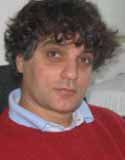Fascioscapulohumeral muscular dystrophy
FSHD is characterised by the progressive wasting of a highly selective set of muscle groups. As the name of the disease suggests, typical muscles affected in FSHD are the muscles of the face and the shoulders. As a result of weakness of the scapula fixators muscle, FSHD patients have problems in lifting their arms. Abdominal muscles also become affected, leading to an abnormal curvature of the spine. Eventually the disease spreads to the lower-limb muscles and as result 20% of FSHD patients require the use of a wheelchair.
- FSHD is the third most common myopathy
- Incidence: 1-20,000
- Inheritance: autosomal dominant

FSHD patients can display asymmetrical distribution of muscle weakness and variability in the severity of the disease even among family members carrying the same genetic defect. For example, monozygotic twins with discordant phenotypes have been described. This suggests that modifier genes as well as epigenetic components play a role in determining the expression of the phenotype in FSHD.
Molecular cause and consequences
.jpg)
The FSHD locus has been mapped to the subtelomeric region of the long arm of chromosome 4 (4q35). It has been shown to be caused by the deletion of an integral number of tandemly repeated 3.3 kb D4Z4 repeat units. D4Z4 contains a transcriptional silencer whose deletion leads to inappropriate overexpression in FSHD skeletal muscle of 4q35 genes located upstream of D4Z4. A candidate gene responsible for FSHD pathogenesis is FRG1, whose expression is co-regulated with that of other genes involved in RNA biogenesis. FRG1 protein co-purifies with the human spliceosome and localises to nucleoli, Cajal Bodies and nuclear speckles. Inappropriate overexpression of FRG1 in skeletal muscles leads to abnormal alternative splicing of specific pre-mRNAs - Tnnt3 and Mtmr1 and results in FSHD:
The regions of TNNT3 and MTMR1 shown normally contain up to 10 and 5 exons respectively. In patients (FSHD1-4) some transcripts are virtually missing and the amount of other transcripts is different. Gene’s structure and Alternative Splicing (AS) events.
Gene's structure and Alternative Splicing (AS) events
To see a full gene diagram and AS pattern of TNNT3 please go to: www.fast-db.com/cgi-bin/main_page.pl?gene_id=784, and for MTMR1 please follow the link: www.fast-db.com/cgi-bin/main_page.pl?gene_id=17227
Molecular approaches to diagnoses and therapy
To find out more, visit: www.treat-nmd.eu (a European network of excellence for neuromuscular diseases). You may also be interested in: GeneTests: International Directory of Genetic Testing Laboratories for FSHD.
EURASNET contact:
Davide Gabellini: gabellini.davide@hsr.it







